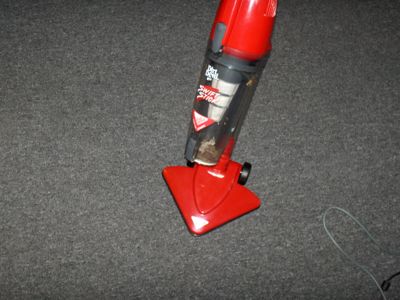Vacuum cleaner
From DDL Wiki
(→Failure Mode Effects Analysis) |
(→Failure Mode Effects Analysis) |
||
| Line 154: | Line 154: | ||
|- | |- | ||
|- align="left" valign="top" | |- align="left" valign="top" | ||
| - | | | + | |Wheel<br />*Allows vaccum to roll |
| - | | | + | | Jammed/Stops turning || Vaccum can no longer roll || 4 || Axel dammage || 2 || Quality control testing || 1 || 8 || Take no action || N/A || N/A || 4 || 2 || 1 || 8 |
|- | |- | ||
|- align="left" valign="top" | |- align="left" valign="top" | ||
Revision as of 21:57, 23 September 2007
Contents |
Executive Summary
During our product analysis of a Dirt Devil Swift Stick we came across several notable observations. As we went through the uses of the product and used them for its main function a few basic problems occured. These problems ranged from small annoyances to major hazzards. This caused us to further look into customer needs and how they can be addressed for this product. Once the product uses and customer needs were completely documented the product was dissected and all of the parts were analysed and documented in detail. This gave us a more complete understanding of how this product was manufactured and assembled. The dissection gave us a basis for further analysis. This further analysis included DFMA, FMEA, DFE, and Quantitative Mechanical Analysis. From these analyses, decisions could be made to improve upon any areas of manufacturing that could be lacking or cause ill effects on the environment.
Product Evaluation
During product evaluation our group used the vacuum cleaner in an everyday use situation. We noted things that worked well along with external problems that occured with everyday use.
Function
Product Uses
For normal use of a vacuum cleaner:
-Unwind power cord and connect unit to home outlet -Power on unit -Move unit in back and forth motion covering the vacuum area desired -Turn off unit -Wind power cord and store
Customer Needs
Bill of Materials
Product Analysis
Design for Manufacturing and Assembly
Current DFMA
Recommended Improvements
Failure Mode Effects Analysis
| Item and Function | Failure Mode | Effects of Failure | S | Cause of Failure | O | Design Controls | D | RPN | Recommended Actions | Responsibility & Deadline | Actions Taken | S | O | D | RPN |
|---|---|---|---|---|---|---|---|---|---|---|---|---|---|---|---|
| Vaccum Channel *Creates channel for vaccum flow | Jams/Clogs | No air flow | 4 | Objects jammed at inlet | 5 | Product testing in normal situations | 3 | 60 | Explore other inlet design options | N/A | N/A | 4 | 5 | 3 | 3 |
| Wheel *Allows vaccum to roll | Jammed/Stops turning | Vaccum can no longer roll | 4 | Axel dammage | 2 | Quality control testing | 1 | 8 | Take no action | N/A | N/A | 4 | 2 | 1 | 8 |
| Chuck Brake *Stops chuck after power is cut | Fails to brake | Brake can no longer stop chuck Chuck spins until friction slows it down | 7 | Brake wears from use | 6 | Failure observed by user | 7 | 294 | Conduct more research to find causes for failure and recommended solutions | N/A | N/A | 7 | 4 | 4 | 112 |
| Casing *Secures mechanical parts *Aesthetics *Provide grip | Non-ergonomic handle | Uncomfortable grip causes blisters or discomfort on user's hand | 5 | Poorly designed casing | 8 | Failure observed by user Quality control testing in lab | 7 | 280 | Redesign case for ergonomic support | N/A | N/A | 5 | 5 | 4 | 100 |
| Battery *Provides voltage | Does not hold charge well | Drill is no longer operable (or at a lower level) due to a short battery life | 7 | Rechargable battery loses charging ability | 8 | Failure observed by user Extended life testing | 5 | 280 | Explore alternative power methods Purchase more expensive, better battery | N/A | N/A | 7 | 6 | 4 | 168 |
Design for Environment
Design for environment (DFE) is method for analyzing the environmental impact of a product. DFE considers a product’s manufacturing processes as well as its use throughout the product’s life cycle.
The environmental impact of a product can be determined through a process called EIO-LCA. This process takes into account all sectors of the econonmy affected by the manufacturing and distribution or the specified product. The EIOLCA software determines the impacts of economic activity, energy usage, greenhouse gas emissions, employment, etc.
For our product we evaluated the economic impact as well as the energy usage for the products life cycle. Using the software we evaluated the economic impact of a household vacuum production for 1 million dollars of economic activity. It was determined that 2.3 million dollars total is needed for production.Economic Impact Using the price of a single vacuum, (30 USD,) we determined the per unit price of manufacturing to be 69 USD. In addition to the evaluation of manufacturing economic impact, we evaluated the impact of electrical use. For our unit we estimated the use to be 100 hr/year. This value considers home use as well as use by cleaning professionals. With the vacuum rating and our electrical supplier’s kw-hr price, the cost for a year of operation is 117 USD/year. Other enviromental effects were also considered and can be seen EIOLCA results
Considering purchase of a vacuum occurs an estimated once every three years, the economic impact from the energy has the larger environmental impact. Our design for environmental efforts will pursue a solution for the energy comsumption.



































